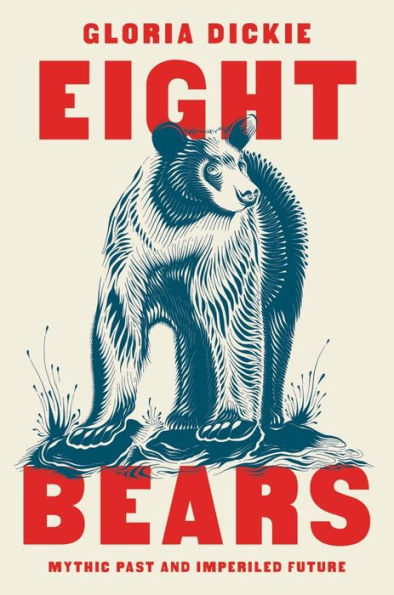Eight Bears: Mythic Past and Imperiled Future
- By Gloria Dickie
- W.W. Norton & Company
- 272 pp.
- Reviewed by Gretchen Lida
- August 2, 2023
What Goldilocks got wrong about the world’s fiercest land predator.

Humans have been in conflict with our fellow predators for millennia, and in the last several hundred years, we’ve exterminated, tortured, and starved out countless so-called “competitors” on an industrial scale. From wolves to whales, our impulse to eradicate creatures below us on the food chain can make reading books about our treatment of animals exceptionally depressing if not downright painful, like touching an electric fence one too many times. So, when I cracked open Gloria Dickie’s Eight Bears, I braced myself for a deluge of cruelty. Instead, I found wonder, awe, melancholy, and terror woven amid stories of the creatures being chronicled.
The book is part travelogue, part nature writing, and part profile. In search of her titular bears, Dickie goes far beyond the confines of America’s national parks, embarking instead on a worldwide tour. She studies ursidae in Vietnam, India, Canada, Peru, and other countries that still have wild ones in their midst. Throughout, the book walks a delicate and essential line of “both/and,” noting that truth is often found in maddening contradictions. Yes, bears have inflicted pain on mankind, but we have also inflicted pain on them. Yes, they are a beloved part of folklore, but they are also archetypical fairytale monsters.
It’s easy to find horror in stories of the anguish people have caused bears. While the starving polar bear — an early victim of climate change — is perhaps the most well-known for its suffering, several other species have a legacy of torment that goes beyond mistreatment and habitat loss. Sloth bears in India, for one, are often kidnapped as cubs and then tortured until they are submissive enough to “dance.” And Vietnam’s sun and moon bears are sometimes kept in captivity, the bile from their livers violently extracted for medicinal use.
These facts are tough to read, yet Dickie doesn’t let us fall into the lazy binary of villain and victim: humans bad, bears good. Instead, she portrays the complexities of each situation. For instance, those same Indian sloth bears that are forced to dance are among the most aggressive species in the wild. Dickie interviews many mauling victims and relatives of those killed by sloth bears. And in a later chapter on North American bears, she provides a nightmare-worthy description of a young woman’s fatal encounter with a bear in Glacier National Park:
“She screamed that the bear was ripping her arm off, then, ‘Oh, my god, I am dying.’”
Yes, Yogi, Teddy, and Paddington are among the sweeter players in the ursa story, but ignoring their violent counterparts would be a disservice not only to the animals themselves but to those working for their preservation. Eight Bears doesn’t just traffic in the good and the bad, however; it also leaves room for the hopeful. Grizzlies, once assumed doomed to extinction, have started returning to former habitats. Pandas — despite their lack of sex drive and Hollywood-celebrity-like fussiness — will likely survive because the public loves them. And in the far north, polar bears and grizzlies are mating with each other, creating a hybrid breed that might “save” the species.
Eight Bears is also lyrical and captures the passions of many scientists who’ve dedicated their lives to the animals they study. It can be read one section at a time, as each chapter stands alone and focuses on a single species. Naturally, it’s best read in its entirety, but in the age of TikTok and tiny attention spans, a scattershot approach may better fit the zeitgeist.
All through the book, Dickie mourns the destruction and brutality inflicted on bears but also wonders how we humans are to live with them going forward. As the number of grizzlies and black bears rises due to successful conservation efforts, so, too, will the frequency of human-bear interactions. What then?
We might find out sooner than we think. In early June, black bears were spotted less than 50 miles north of my home in Chicago — the freaked-out gossip over which reached me even before news reports, as folks panicked about what to do with their pets and their garbage bins. I couldn’t help but notice the irony as I caught the train that day from Wrigley Field, home of the (wait for it) Chicago Cubs. Bear imagery was everywhere, and the wisdom I’d learned from Dickie’s book sang in my head as I walked past ursa-adorned statues and baseball hats.
Black bears almost always figure out how to open “bear-proof” latches, and grizzlies are famously — and tenaciously — territorial. Yet it’s this very cleverness and tenacity that make bears such a worthy foil. They’re nearly as intelligent and dangerous as we are; they connect us to our own wildness. There’s no straightforward answer to the age-old question of how we learn to live in harmony with them, but the excellent Eight Bears may get us closer to finding one.
Gretchen Lida is an essayist and an equestrian. Her work has appeared in the Washington Post, the Rumpus, the Los Angeles Review of Books, and many other publications. She is a contributing writer to Horse Network and the Independent and host of “HN Reads,” a podcast about horse books. She lives in Chicago.

